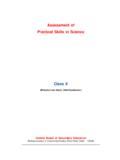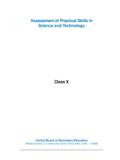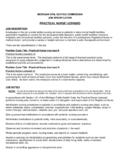Transcription of Mathematical Abilities and Mathematical Skills
1 World Federation of NationalMathematics CompetitionsConference 2006 Cambridge, England22 28 July 2006 Abilities andMathematical SkillsAlexandre V. Borovik and Tony Gardiner1. Why do we need this discussion?The concept of Mathematical Abilities is not something that is frequently discussed. Atthe personal level, however, almost every mathematician and Mathematical educator hasrelatively firm views on the subject. In this document, we summarise less disputed aspectsof the highly complex phenomenon and some of its immediate implications for participants of this Conference run mathematics outreach programmes and math-ematics competitions in countries with very diverse educational and cultural traditions. Itwould be futile to try to seek a single universal solution to educational and methodologicalproblems that we encounter in our work. However, we have one thing in common: we workwith mathematically able children. It is likely that some of us feel that their work goesagainst the grain of prevailing trends in educational policy and practice.
2 It is likely thatmany of us are familiar with such phenomena as the dumbing down of the curriculum and teaching to test . The task of explaining the importance of proper Mathematical educationto policymakers and to the wider public becomes ever more challenging. It is even morechallenging to explain, to the lay person, the nature of Mathematical Abilities in and developing our work, we have to reach a wider circle of teachers andparents. Given a widespread prejudice against mathematics, what can we say to them aboutmathematics and Mathematical Abilities ?c 2006 Alexandre Borovik, document may be reproduced in whole or in part for non-commercial educational pur-poses, provided that the information quoted is reproduced without adaptation and the sourceand date of publication are document will be placed on the Internet avb/ V. BOROVIK AND A. D. GARDINER2. What can we say to a non-mathematician?When talking to a non-mathematician, Mathematical Abilities can be usefully comparedto musical Abilities : in their developed form they appear highly specific, but are in factquintessentially human, and so are widely spread in the population at large in all socialand ethnic groups.
3 Like music, mathematics is a personality-building activity, it shapes theway the learner thinks and sees the world. As with music, mathematics has a profoundeducational impact even where someone no longer uses their Mathematical training in laterlife. Like music, success in mathematics depends on systematic, cumulative learning, andeach new skill needs to be built on a solid foundation laid at earlier mathematics is often thought to be a cold subject, this is a profound misun-derstanding. As with music, mathematics requires a high level of motivation and emotionalinvolvement on the part of the learner. Understanding is of course vital; but it is also essen-tial for the learner to experience real difficulties: boredom and lack of challenge present fargreater dangers when seeking to nurture Mathematical talent. A degree ofchallenge andfrustrationare has the ability to learn mathematics, although some children learn and makeconnections more quickly than others.
4 Everyone has some Mathematical ability, but somechildren have potential far beyond what most people are prepared to believe. Mathematicalabilities in a child are often dormant and remain unnoticed both by the child and his orher teachers. This potential can be lost forever if it is not discovered and supported atthe appropriate time. It may even be undermined by inappropriate experience: again, acomparison can be made with music, where a dissonant musical toy can seriously damage achild s perception of Mathematical traits appear at different ages. To develop a pupil s mathematicalabilities effectively, one must tap into these Abilities at appropriate times. A comparison canbe made with language learning: almost every 7 year old child can master a foreign languagewith ease, though for an adult it could be an almost impossible task. Similarly, there areperiods in a child s development when he or she is may respond to formal procedures andalgorithms, and there times when they can be excited by the discovery of a new mathemat-ical activity: generalisation.
5 Matching a talented child s Mathematical experience to theircognitive development is a challenge for every teacher since every child will be different!3. StratificationAbilities form a continuous spectrum; for the purpose of this discussion, we identify twogroups of schoolchildren the top 20% and top 1% in the school. The percentiles of 20%and 1% are chosen not for any intrinsic reasons but for purely practical purposes. Thecohort of 20% is likely to include most of those who will end up working, in their adult life,in professions that require some Mathematical background ( beyond mere numeracy );these professions include engineering, information technology, the financial sector, etc. Thegroup of 20% is sufficiently large to warrant the allocation of significant effort and resources toensure that such a group can be realistically supported and nurtured within every school, viaMATHEMATICAL Abilities AND Mathematical SKILLS3a sufficiently enriched curriculum, exciting problems and, of course, teachers (and appropriateprofessional development).
6 Most importantly, we need some of the top 20% (and the best ofthem) to return to school as teachers of top 1% group (in effect, 2 3 pupils per year in an average British school) shouldperhaps be more of concern to the professional academic community than to their in this group have the potential to join the next generation of mathematicians andcomputer scientists; they could become confident users of advanced hardcore mathematicsin science, engineering, biotechnology and the financial sector. Everyone who works withgifted children in Mathematical competitions and other outreach activities knows, that, assoon as such a child is encouraged in his or her interest in mathematics and is given somesupport and sufficiently challenging problems to solve, he or she rapidly outgrows the levelof his or her school. We could not realistically expect that the school can provide sufficientintellectual nourishment for this group of children. But the health of the professional math-ematical community and the needs of society demand that the top 1% group is not lost tomathematics and is nurtured via a network of outreach and enrichment activities run byuniversities and other professional in many countries shows that much of what we say concerning the select 1%group applies to the wider group of 20%.
7 4. Traits of mathematically able childrenWe by-pass a discussion of the deeper cognitive structures responsible for mathematicalabilities, and offer a list of traits that might describe able mathematicians. We emphasise thatthese are possible indicators: those listed are not always present and the list is by no meansexhaustive. Different traits start to manifest themselves at different stages of development;some appear only when a child is exposed to sufficiently rich and deep mathematics. Thelist has been carefully compiled, but is designed to be suggestive: it is neither complete, norsystematic. Ability to make and use generalisations often quite quickly. One of the basicabilities, easily detectable even at the level of primary school: after solving a singleexample from a series, a child immediately knows how to solveallexamples of thesame kind. Rapid and sound memorisation of Mathematical material. Ability to concentrate on mathematics for long periods without apparent signs oftiredness.
8 Ability to offer and use multiple representations of the same Mathematical object.(For example, a child switches easily between representations of the same functionby tables, charts, graphs, and analytic expressions.) An instinctive tendency to approach a problem in different ways: even if a problemhas been already solved, a child is keen to find an alternative solution. Ability to utilise analogies and make connections. Preparedness to link two (or more) elementary procedures to construct a solutionto a multi-step V. BOROVIK AND A. D. GARDINER Ability to recognise what it means to know for certain . Ability to detect unstated assumptions in a problem, and either to explicate andutilise them, or to reject the problem as ill-defined. A distinctive tendency for economy of thought, striving to find the most econom-ical ways to solve problems, for clarity and simplicity in a solution. Instinctive awareness of the presence and importance of an underlying structure.
9 Lack of fear of being lost and having to struggle to find one s way through theproblem. A tendency to rapid abbreviation, compression or a curtailment of reasoning inproblem solving. An easy grasp of encapsulation and de-encapsulation of Mathematical objects terms are less frequently used, and perhaps a few words of clarificationmay be useful; we quote Weller et al. [3]: The encapsulation and de-encapsulation of processes in order to perform ac-tions is a common experience in Mathematical thinking. For example, one mightwish to add two functionsfandgto obtain a new functionf+g. Thinking aboutdoing this requires that the two original functions and the resulting function areconceived as objects. The transformation is imagined by de-encapsulating backto the two underlying processes and coordinating them by thinking about all ofthe elementsxof the domain and all of the individual transformationsf(x) andg(x) at one time so as to obtain, by adding, the new process, which consists oftransforming eachxtof(x) +g(x).
10 This new process is then encapsulated toobtain the new functionf+g. We use the term traits to emphasise that they are not just inborn; in a supportivelearning environment, they may develop and flourish to spectacular effect, starting from thechild s first shy attempts to try something unusual with a Mathematical emphasise again that attempts to assess Mathematical ability are necessarily one-sided: a test or a child s performance may confirm the presence of significant mathematicalability; however, failure to perform does not necessarily mean that the child has less , there are specific instances when Mathematical Abilities can be easily missed (andthe list can be easily expanded): For example, able mathematicians are frequently quick thinkers. However, someable children appear to be slow perhaps because it is natural for them to thinkabout a problem in a form more general than the one given. Some children have a powerful ability for visualisation that allows them to instantly see the solution; after that they may have difficulty expressing their answer in therigid form required by their teachers or textbooks.











